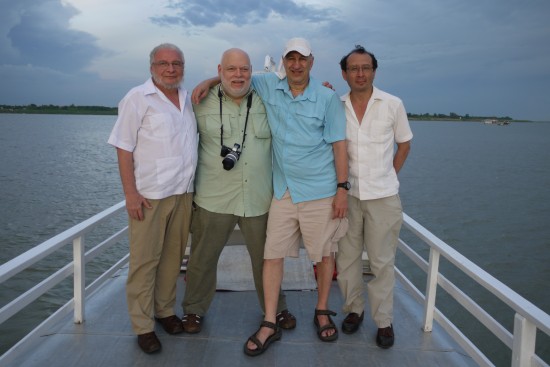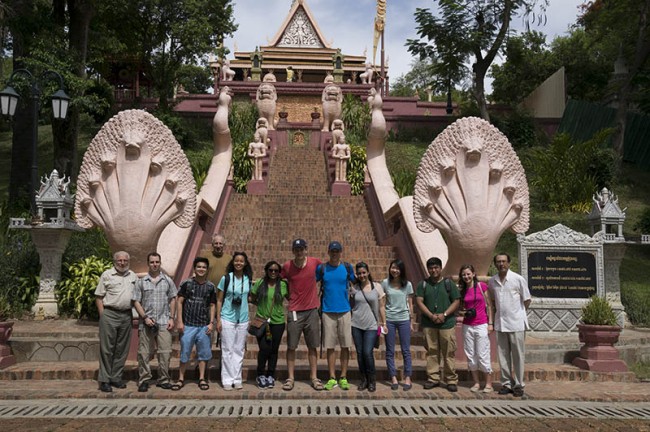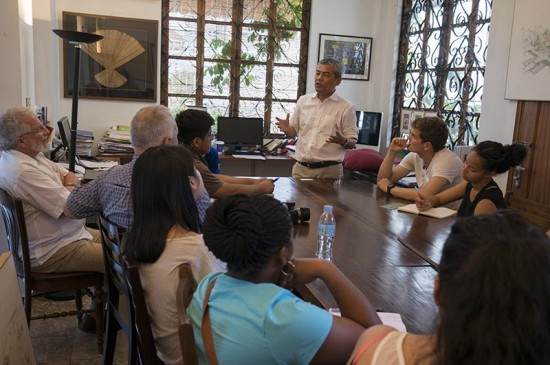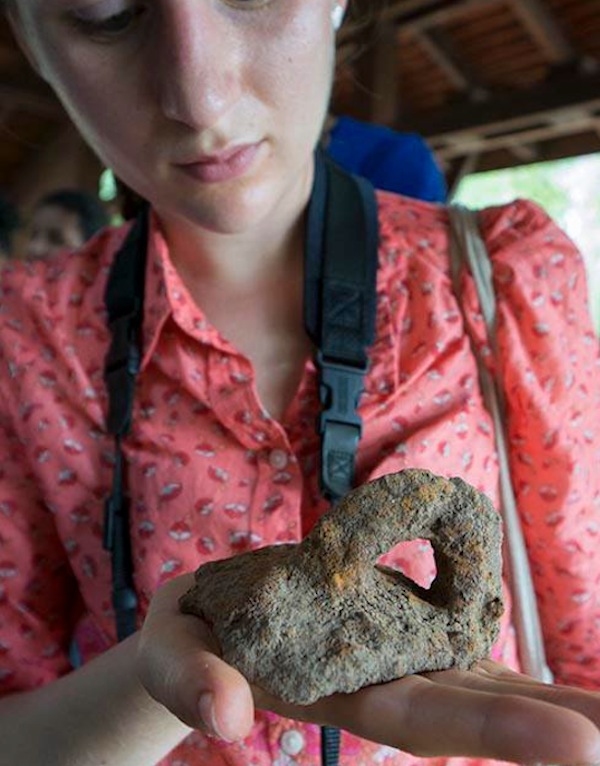
“HIST 366: Interpreting the Ancient City: Angkor” was a hands on field investigation that traveled to Cambodia in May and June. Launched with the scholarship aid provided by the O’Neill Asia Cum Laude Endowment and the Charlotte Riggs Scholarship fund, ten Trinity students and four professors were able to travel to Phnom Penh and Siem Reap to do in depth study of ancient and modern Cambodia. History Department professors Michael Lestz and Dario Euraque, and Prof. Pablo Delano (Studio Arts) led the ten Trinity students to Phnom Penh and Siem Reap in a rich exploration of the themes of the course. As we visited material remains of Angkorean cities just north of Cambodia’s great freshwater lake accompanying the group as an associated faculty member was Dr. Rodolfo Pastor Fasquelle, who served twice as Minister of Culture of Honduras, between 1994 and 1998, and between 2006 and 2009. Faculty and students benefitted from Dr. Pastor Fasquelle’s vast knowledge of the ancient Mesoamerican world and especially the Mayan World Heritage site of Copan in Honduras.

The principal focus of this course was an examination of the political structure, social fabric and cultural florescence of the ancient cities of Cambodia. Attention was paid to the earlier Maya cities of Mexico, Honduras and Guatemala and parallel issues in the Latin American setting. The dissonance between empirical records of the ancient Khmer and Maya civilizations and the narrative of national history as it emerged through colonial and post-colonial times was addressed as students discovered and analyzed their own documents using the tools of archaeology and documentary photography and using existing historical records to form a textured vision of ancient cities and how they came to be understood.

This was done in the context of reflecting on the relationship between ancient cities and cultures, and national narratives, identities and how postcolonial states register these central themes in museums, archaeological parks, and venues and institutions of current renditions of traditional arts and the modern, contemporary art scene in Cambodia. Briana Chang, ’16 captured the complexities of these concerns when she noted, “After reading “The Art Museum As a Ritual” by Carol Duncan, I have been thinking about the museum’s relationship to the people it represents. Prof. Lestz pointed out that much of the National Museum of Cambodia was organized by French historians- the building at one point was even named after the French governor of Cambodia at the time, Albert Sarraut. Does this mean that the French and not the Cambodian people themselves have shaped the nations identity? Could it be possible that all the statues and paintings were minor elements of ancient life, but the museums made them major focuses of the culture? How did the historians decide what was important to a community they were not originally a part of? What were actual important parts of Cambodian culture?”

Students and faculty from Trinity College’s Cambodia-in-Context 2013 program visited archeological excavation sites at the world famous Bayon Temple, guided by American archeologist Robert McCarthy currently associated with the Japanese Government Team for Safeguarding Angkor. The course was extraordinarily lucky to be guided by Dr. McCarthy who, according to Prof. Lestz, devotes, “each day to unraveling the many mysteries of Angkor. He showed us the ancient city as it is seen by an archaeologist. As we stood beside him, he pointed out the shining fragments of Chinese celadon and painted terracotta that today are the traces of the lives of hundreds of thousands of Khmer who once lived in the shadow of the Bayon. He pointed out a bored devata (a type of standing goddess carving repeated often on the Bayon), that was unlike any other. She stands of the wall of the west Bayon balancing on one foot on the other with a distant gaze that has pierced the centuries. He recounted his pursuit of the obscure markings of ancient hydrological engineers that pointed out the course of vanished drainage systems and conduits never before well understood McCarthy also underlined the dangers of inadequate conservation efforts in a site that will soon confront 6 million visitors per years. His presentation was a tour de force by an impassioned scholar. What a privilege to see Bob’s nagara (city).”

In addition, the students gained a cognizance of the role played by the United Nations Education, Scientific, and Cultural Organizations (UNESCO) in the designation and administration of “world heritage sites” in the Cambodian and Central American context. They learned how Waseda University from Japan, the Center for Khmer Studies, and Sydney University’s Khmer Research Center have created new research pathways that are enabling the rewriting of Cambodian history.

Through perusing two distinct post-colonial contexts, French and Spanish, students saw how history is recorded a dynamic relation with colonial and post-colonial political domination. In this regard, visits to the Royal Palace in Phnom Penh, built during the time of Napoleon III, provided a perspective to understand how a dimly appreciated past was mobilized by the French to justify their ninety years of exploitation of Cambodia and other states that formed l’Union d’Indochine. Attached is a photo of the History 366 students and faculty taken in the Royal Palace in Phnom Penh in a visit designed to encourage an understanding of the uses of the past as a tool of colonial domination.

The work this summer was founded on a ten year record of research and teaching engagement by faculty and students with Cambodia. Such major figures in Khmer studies like Professor Ben Kiernan of Yale University, the founder of the Cambodian Genocide Project, and the film maker Socheata Poeuv, who screened her autobiographical New Year Baby on the experiences of her family during the Pol Pot era, as well as artists and dancers from Cambodian Living Arts, have visited our campus regularly. In addition, the faculty principals in the effort has made Cambodia a vital stream of their academic activity: The chair of the History Department Michael Lestz has completed a new translation of Zhou Daguan’s 13th century manuscript A Record of Cambodia, which was used as a core text for courses at Trinity College and summer field investigations; Professor Pablo Delano has assembled a major body of photographic work on Cambodia.

Professor Delano drew on his experiences in Cambodia and elsewhere in the world to design an assignment charging students to produce a photographic. Besides documenting our experiences in Cambodia he coordinated a very privileged, private conversation with John Vink, the renowned Belgian photo journalist now living in Cambodia. In an informal chat with the students, he spoke frankly about his attraction to Cambodia, his methodology and the challenges and benefits of working in Cambodia as a foreigner.
We also visited Vink’s most recent photographic exhibition at Meta House (German Cultural Center in Phnom Penh). Vink is a member of the prestigious Magnum photography agency, and he has lived in Cambodia for the last 12 years, devoting that time to methodically documenting all aspects of contemporary life and current events. Professor Dario Euraque has joined this project with his unique perspective on archives, cultural heritage issues, and ancient sites in Central America acquired when he served as Director of the Honduran Institute of Anthropology and History between 2006 and 2009, then reporting to Dr. Pastor Fasquelle as Minister of Culture. This labor of love has yielded eight new undergraduate, and four field investigations in Southeast Asia. This effort is unique for History. No other group combinations of campus study combined by work abroad have hitherto been spearheaded with a history component in the center of the enterprise.
[Photographs by Professor Pablo Delano]